Project of the Week
This week's instalment of the #SBIDinspire interior design series features an inspiring and thoughtfully designed children’s educational centre and a picture book library. With health and safety for the educational centre and library a priority, the education-centric design incorporates features such as air monitoring, hand disinfection stations, temperature monitoring and strict security. In additional, all materials are eco-friendly, non-toxic and child-friendly. From the strictly monitored entrance, children can explore the space by following colours and ‘flight routes’ to arrive at their destination. The interior is equipped with children’s toilets, drinking fountains and features to assist the children in their personal development. Besides meeting the need for children to play freely, safely and happily, the design also ensures parents have a relaxing and elegant environment in which they can rest, read and enjoy a coffee break.
Sector: Education Design
Company: Taipei Base Design Center
Project: Dou Dou Education Center
Project Location: Shanghai, China
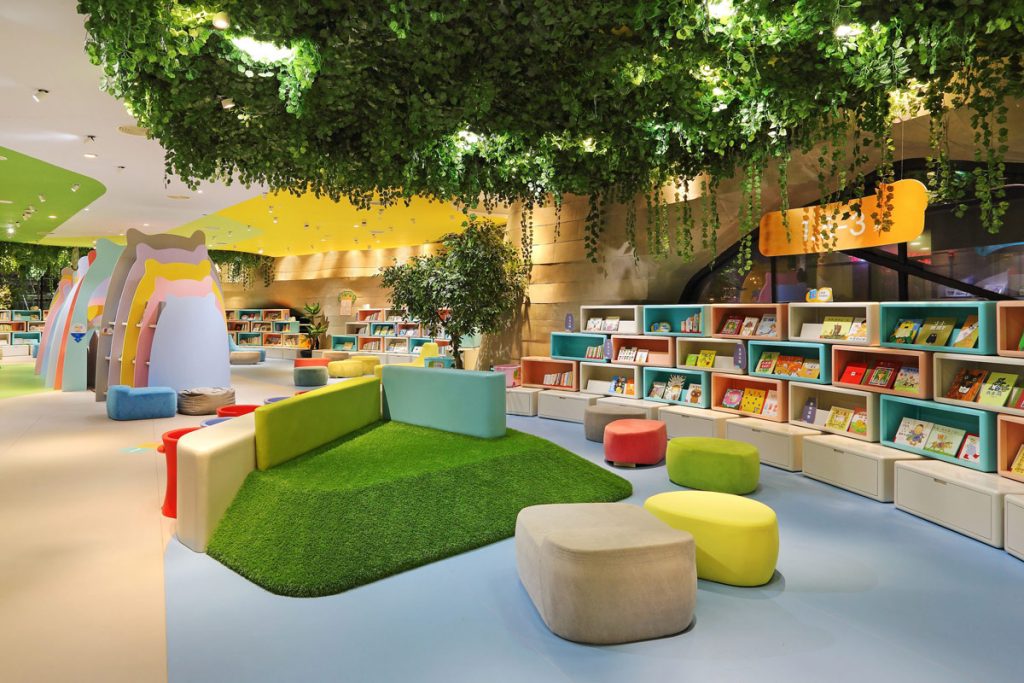
What was the client's brief?
“Fantasy Works” is a newly-established company, with the sub-brands of Fantasyland, which combines child fun and modern technology and of Dou Dou, which is separated into the two series of early childhood education and picture books. The major appeals include the collection of over 10,000 picture books and over 2,000 English picture books. The books of National Geographic Learning are introduced to Shanghai for the first time together with S.T.E.M. The future prospect is to open branches all over China through direct selling, franchising, authorisation or brand cooperation.
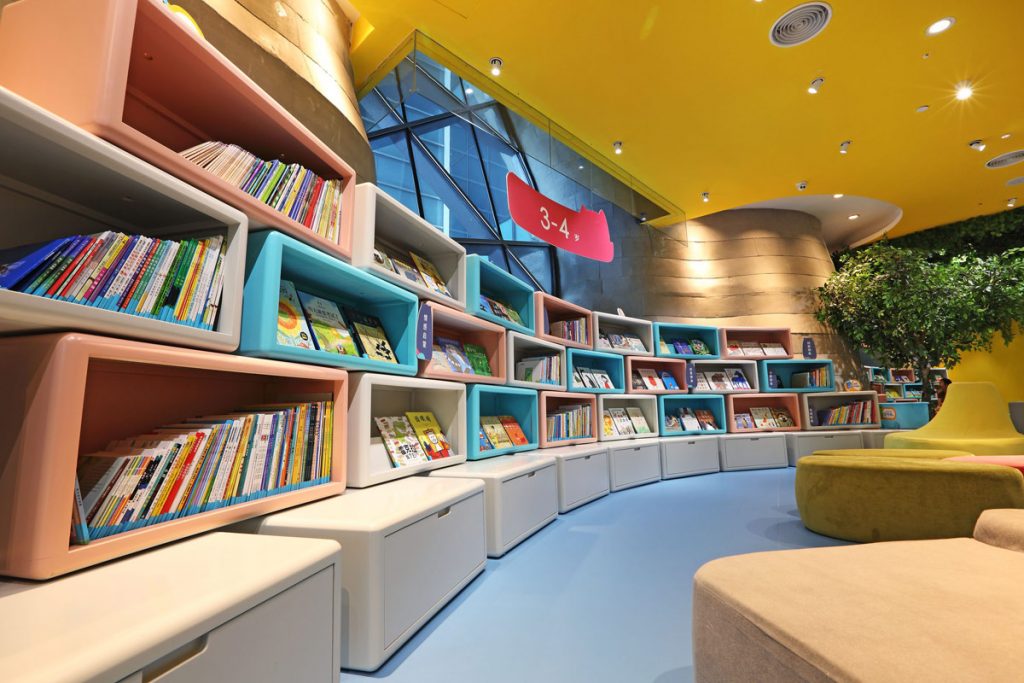
What inspired the interior design of the project?
Nothing “hard” can be found in Dou Dou Fun Reading Forest Picture Book Library. The differentiation in the content, service, and environment has been achieved. The super-large area, huge number of books, and cross-field cooperation have all manifested the positive attitude, or ambition, to become the best of the best. It will become a model in China. However, we also saw parents have loving interactions with their children on the furniture, which were designed to be sat on “uprightly,” to indulge themselves in the stories of the picture books. We have also seen some parents just leave their children to the guiding teachers and take time for themselves to go shopping. For TBDC, the value judgement of the parents and the way to educate their children are the keys to deciding whether the space is beautiful and was the driving force for inspiring the final design of the project.
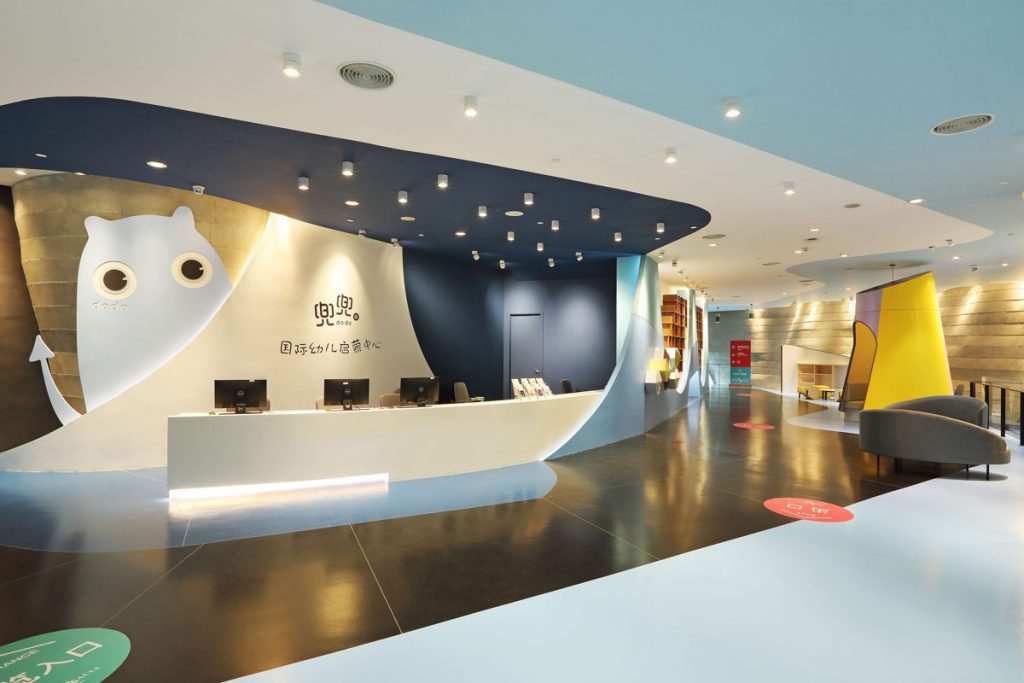
What was the toughest hurdle your team overcame during the project?
This project is located at the central of the Zen Himalayas Center, Shanghai. It was essential that the original ceiling, wall and floor remain intact during the project development; therefore, we employed props which can be used in random combination to satisfy all kinds of functions, as well as lower the cost and shorten time.
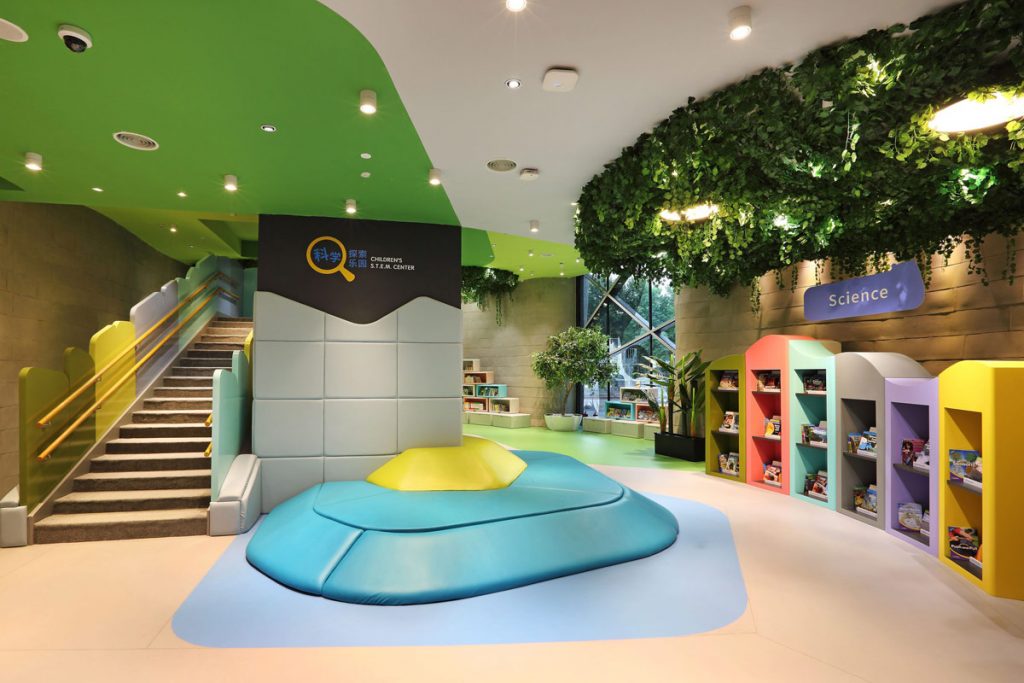 What was your team’s highlight of the project?
What was your team’s highlight of the project?
The point of the education design focuses on the space being exclusively for children. Besides the basic elements of safety and sanitation, there are also proper arrangements for the operation flow and all kinds of activities, whilst catering to the needs of all ages. Seeing the impact this space has on the children and parents who are using it brings us the greatest sense of achievement.
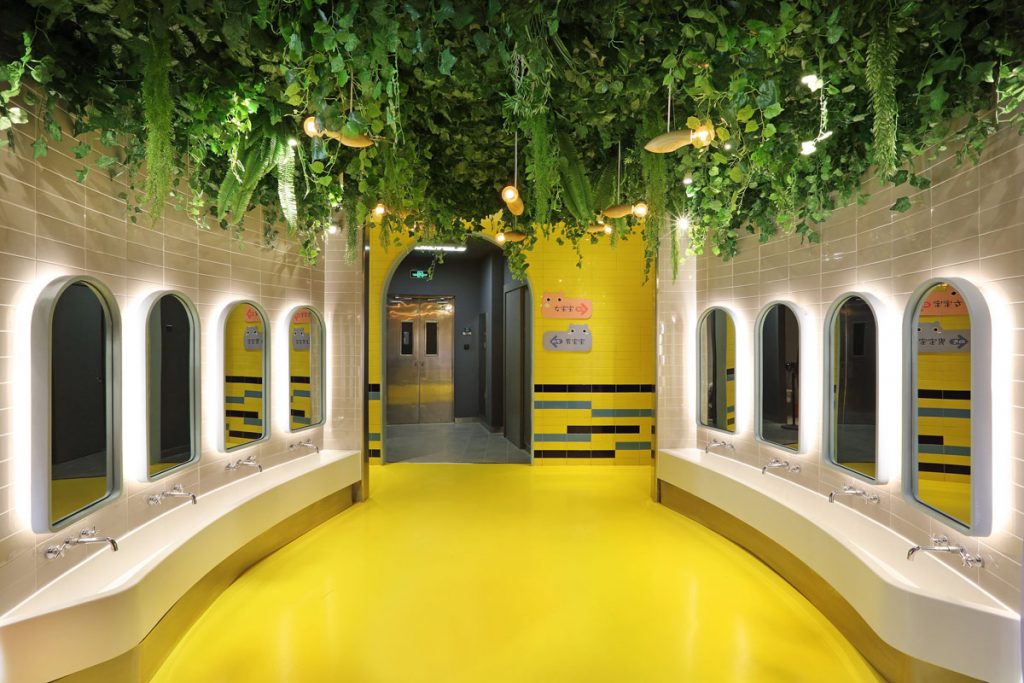
Why did you enter the SBID International Design Awards?
The SBID International Design Awards is one of the most prestigious interior design awards, which recognises the excellence of interior designs. It would be an honour to be recognised by SBID International Design Awards, which will prove TBDC and our project to be an inspiring and high calibre project within the high standard of the industry. Also TBDC hope that Asian design and the Asian market can be seen and appreciated worldwide. TBDC are more than overjoyed to be chosen as this week's Project of The Week.
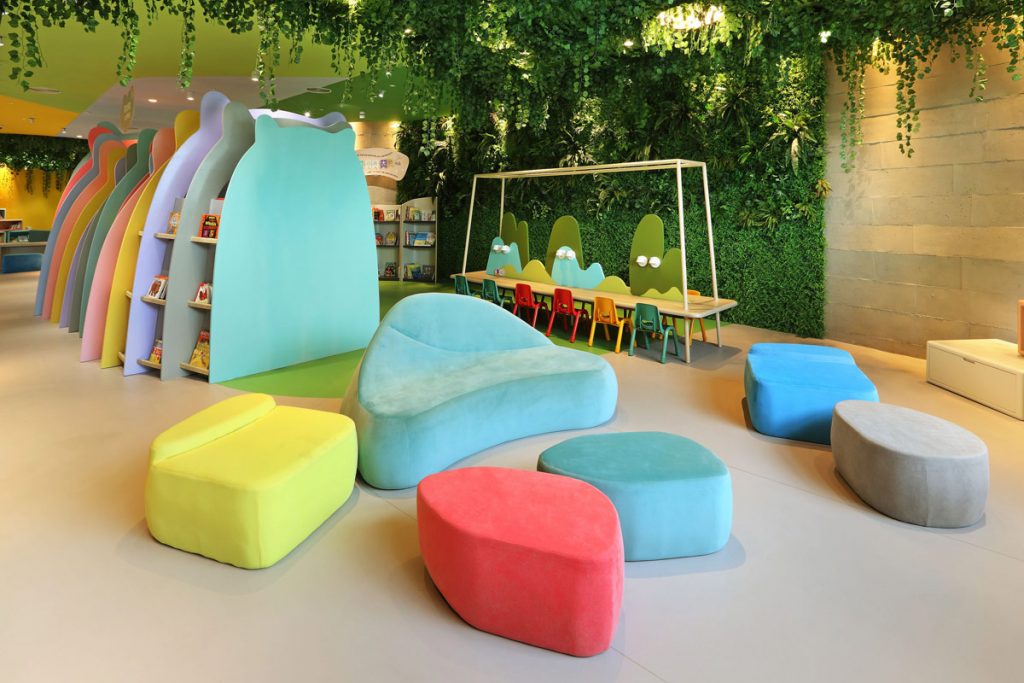
Questions answered by Janus Huang and Roy Huang, Chief Designers of Taipei Base Design Center
If you missed last week's Project of the Week featuring the biggest Lush Fresh Handmade Cosmetics store in the world, situated in the heart of Liverpool, click here to see more.
We hope you feel inspired by this week's education design! Let us know what inspired you #SBIDinspire
Taipei Base Design Center | SBID International Design Awards
Image credits: Zhong Han
The SBID Education Council puts effective design at the core of the learning process. With the aim of raising awareness in showing how evidence-based interior design decisions can transform learning experiences, member of the Education Council, Dr Pamela Woolner shares her views on learning environments. Pamela is the Degree Programme Director for EdD at Newcastle University and has carried out extensive research which centres on understanding and developing the physical learning environment.
The physical environment makes a difference to education – a setting will facilitate some teaching, learning and social practices while hindering others. Therefore, the best results occur when physical space and material resources are aligned with pedagogical intentions. It also means that space can be a powerful driver of educational change, but only if developed purposefully and in co-ordination with changes to other elements, such as curriculum, relationships and practices.
These ideas apply across a school's premises, but furniture, furnishings and interior design form an interesting part of the overall environment. It is often possible to change the internal organisation and appearance of a school relatively cheaply and quickly, and there are considerable possibilities for involving school users, staff and students, in the process of planning and designing new spaces. So it is unfortunate that school interiors can be overlooked, particularly during times of big school building programmes, such as we have seen in recent years in the UK, Australia and elsewhere in the world. As an example of the potential power of interior design, consider the example of acoustics. Structural decisions, but also choices of furnishings and finishes, can reduce unhelpful reverberation and noise leakage between areas. This can be vital in enabling teacher decisions to drive learning practices, balancing activity and stillness, group work and individual projects. In contrast, in many schools, unsuitable environments, both poorly thought-out open space and enclosed rooms with thin walls, cause students and teachers to adapt their behaviour to avoid disturbing other people.
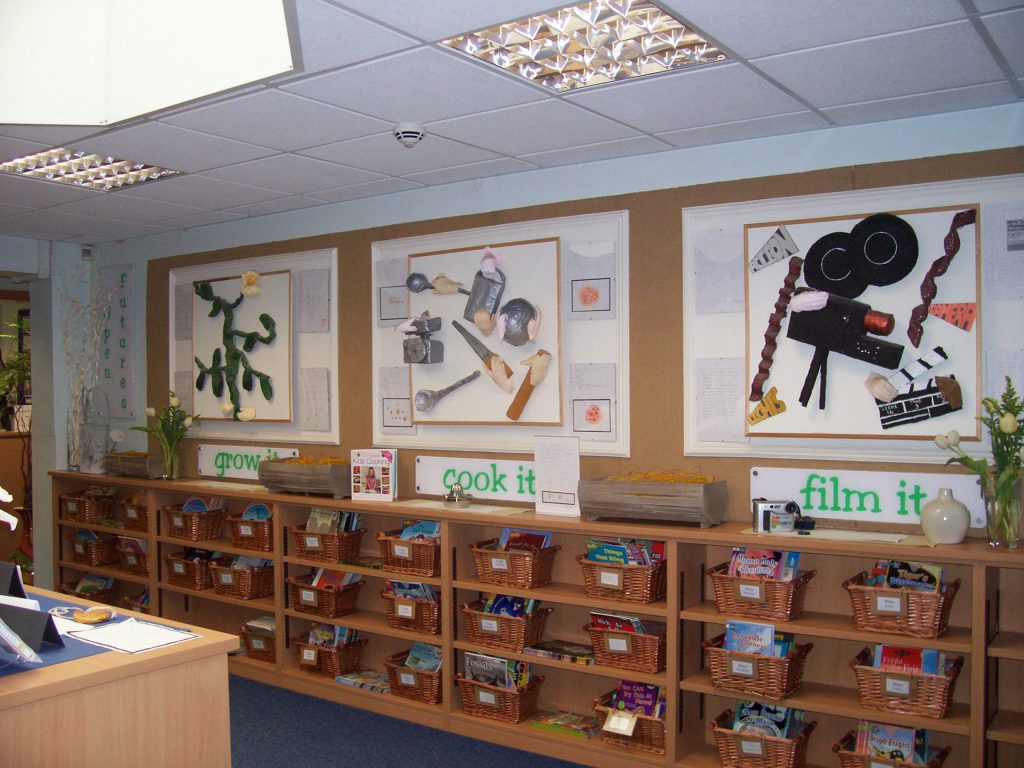
I've recently written about how two schools in the north east of England used their environments to support developments in teaching and learning to enrich student experiences and improve outcomes. A primary school, which we've referred to as Southside, got involved with a skills and enquiry programme, Open Futures. The intention was to change teaching and learning through four integrated strands of curriculum development centred on cooking, gardening, filming and philosophy for children. Through a very different process, our other example school, Town End Academy, set out to develop an enquiry-based, cross-curricular approach to learning, which is challenging within the English secondary school climate of individualised, subject based learning and high stakes tests.
 Southside
Southside
At Southside, involvement in Open Futures acted as an immediate catalyst for changes that the school had been hoping to make in curriculum content, teaching approaches and use of school space. Cooking and growing spaces were developed, as was a base for the film strand, staff went on training courses for the individual strands, while timetables and budgets were adapted to accommodate and resource the programme. These initial changes helped to support innovation, but it was subsequent developments that enabled the change to be sustained and, we judged, start to become 'institutionalised'. Less tangible, but important, changes to educational practices and values were underpinned by more self-evident innovation across the curriculum, staff training and the school environment, inside and out. Finding school space for Open Futures, from the usual noticeboards to the 'wonder tree' in the corridor, which children across the school could use to ask questions and offer answers, demonstrated that the programme was valued and encouraged further engagement.
Town End Academy
At Town End, initial innovations centred on staff development and timetabling to support cross-curricular, enquiry-based learning. However, teachers were also encouraged to rearrange the furniture in the classrooms to facilitate the necessary student collaboration. Circular tables were put into some rooms, while, in others, desks were rearranged so that students could sit facing each other. Further developments into learning through extended collaborative 'projects' made more demands on school indoor space, including space to research and develop project ideas, as well as areas for end of project exhibitions and displays. Tending to work against the cross-curricular intentions was the school interior plan with its subject-specific offices that teachers use for planning, but also during breaks and lunchtimes.
Across both these schools, it's clear to see that educational change is linked to the physical environment. Existing space can either support or constrain change, with redesign offering a usefully visual and tangible focus for the development of new practices. Furnishings, equipment and areas within these schools were used to support initial innovation, then embed the changes and enable ongoing development.

Dr Pamela Woolner
Degree Programme Director for EdD at Newcastle University
Click here to find out more about the SBID Education Council
For more information on these schools, discussion of the challenges of whole school change and ideas about using school space to entrench innovation, click here to read the free access article.
Full reference: Woolner P, Thomas U, Tiplady L. (2018) Structural change from physical foundations: The role of the environment in enacting school change. Journal of Educational Change, 19(2), 223-242.
The SBID Education Council is hosting an event on the Tuesday 26th June to discuss how improving wellness in learning environments can improve attainment. Sponsored by Interface and Orangebox, The event is open to interior designers and architects, but teachers and educational decision makers are also welcome to attend.
Two talks will be held at 11.00am and 12.10pm by Jim Taylor, Head of Design and Wellbeing at Orangebox and Oliver Heath, Interface Partner and Biophilic Design Expert.
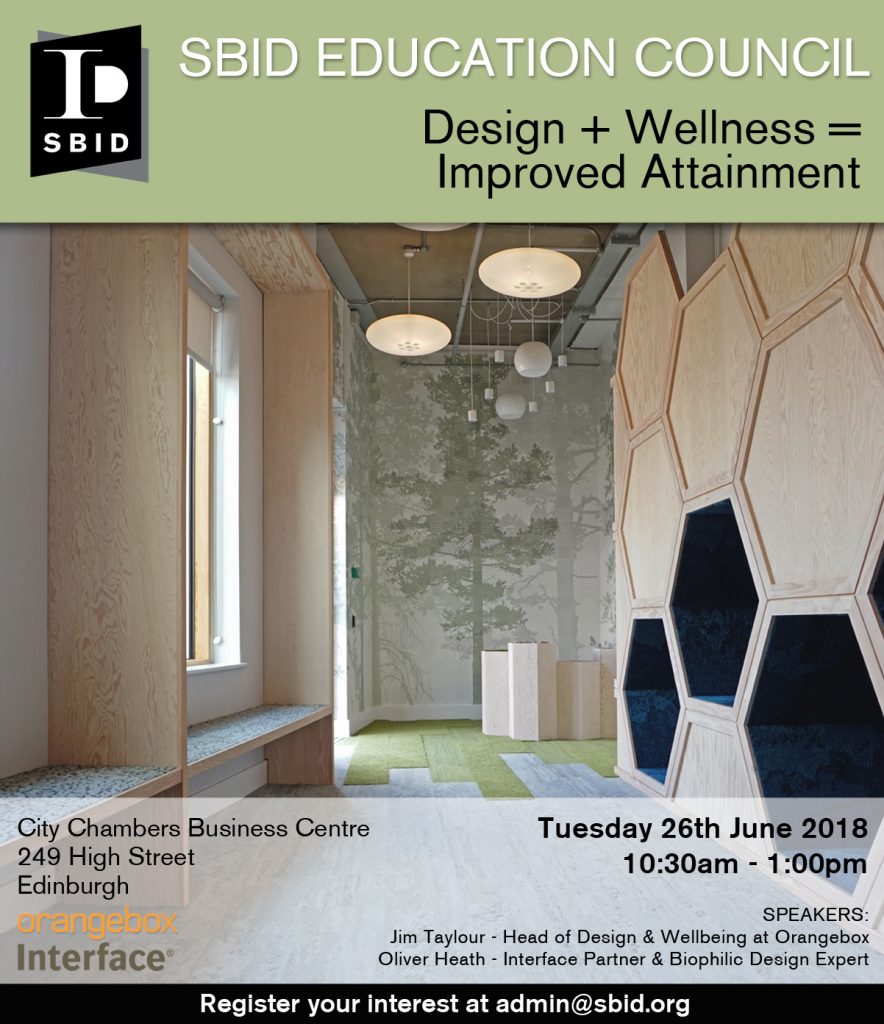
Wireless Well Learning
11.00am - Jim Taylour
Jim trained as a furniture designer and ergonomist, working in the furniture industry for 30 years both in a specialised occupational health capacity and in mainstream workplace design and research. He heads up Design at the Orangebox UK based manufacturing centre in South Wales and also chairs the Institute of Ergonomics and Human Factors special interest group on children’s ergonomics to represent the industry furniture standards across Europe through the British Standards Institute.
His recent publications include 'Mobile Generations' exploring Agile Smartworking and the emerging health and productivity challenges affecting the workplace. As a result of the findings an initiative developed by Jim is 'wireless well working', a workplace strategic design tool to help organisations shape their environments to support their own wellbeing and collaborative initiatives. Jim will talk to us about his recommendations and basic rules for selecting furniture for classroom environments to improve the quality of interior design in education.
Learning from Nature: Biophilic Educational Spaces
12.10pm - Oliver Heath
Oliver is a qualified Domestic Energy and Green Deal Assessor who founded an architectural and interior design practice, combining sustainability, consumer engagement and communications to inspire the uptake of future thinking in the built environment.
Biophilia (meaning love of nature) focuses on human’s innate attraction to nature and natural processes. It suggests that we all have a genetic connection to the natural world built up through hundreds of thousands of years of living in agrarian settings. Biophilic Design uses these ideas as principles to create a human centred approach that when applied improves many of the spaces that we live and work in today, with numerous benefits to our health and well-being.
Our built environment features a huge range of educational buildings, of all different scales and capacities: from small nurseries through to vast schools and university campuses – many of which resemble self-contained villages. However, what these buildings all have in common is that staff members and students inhabit them on a daily basis in order to teach and learn. Research has proven that our attention capacity (essential for our cognitive functioning) is restored when we come into contact with nature. Studies have demonstrated that Biophilic educational spaces have the ability to improve performance and the well-being of both staff members and students.
In the Volume 6 Issue 4 edition of eSociety, SBID spoked to ergonomics specialist Jim Taylour about his recommendations and basic rules for selecting furniture for classroom environments to improve the quality of interior design in education.

Here's what Jim had to say about the current standards of classroom furnishings...
As an adult, have you ever been to a conference and felt restless because of the uncomfortable chairs, dined out where there's minimum legroom and the acoustics prevent you from hearing your fellow diners properly, or sat on a sofa and thought how deep, low and ill-fitting the experience was, and how it impeded your concentration?
Now consider revisiting these scenarios on a daily basis for a period of 14-plus years and that's beginning to paint a picture of the unintentionally hostile environments we expect children to survive and thrive within school.
Dimensional misfit between children and the equipment provided often causes poor posture, which in turn increases the risk of error, accidents, discomfort, loss of concentration and poor productivity.
At secondary school age, classroom physical activity drops year-by-year, concentration demands increase and the reliance on technology locks students into motionless postures - all on furniture that is non-adjustable and considered non-compliant in the contemporary office.
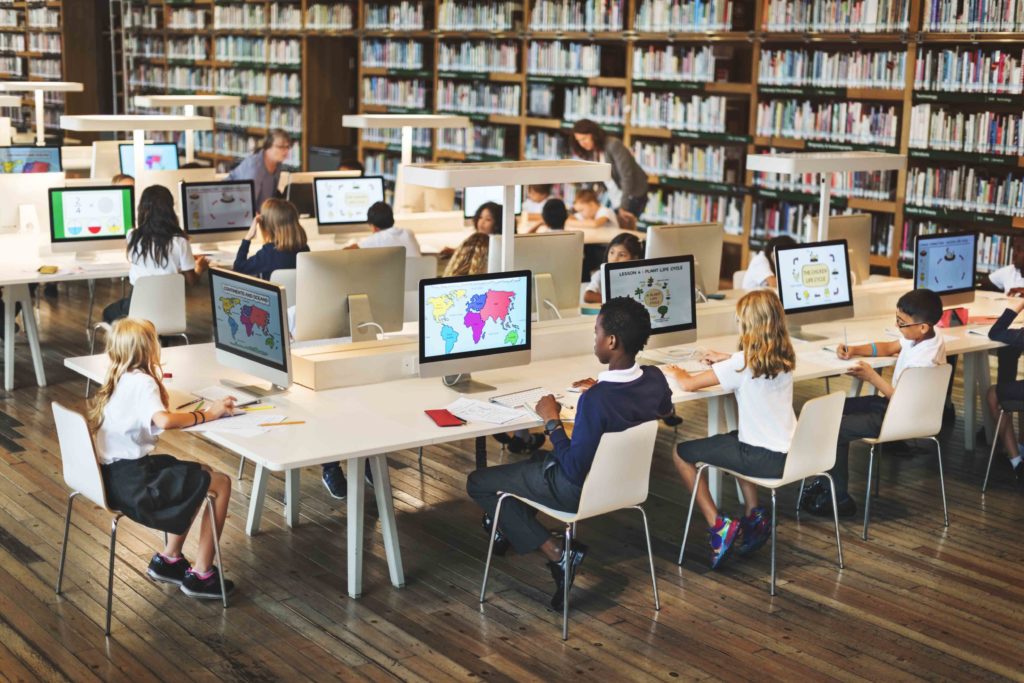
How to select furniture responsibly
Jim lays out his set of recommendations ranging from the selection of suitable chair sizes and the importance of providing variety and choice, to assessing the adjustability and flexibility of chairs to ensure they are fit for purpose and even considering unique features to suit specific tasks which will aid comfort and posture for the activity at hand. Find out what suggestions Jim made reading the rest of this feature!
Read this feature →
Jim Taylour, a member of SBID's Education Council and Head of Design & Wellbeing at Orangebox
Contact: Jim.Taylour@orangebox.com
This feature originally appeared in the Education section within Volume 6 Issue 4 of the official SBID interior design magazine, eSociety.
Click here to read the full issue.
Britain was represented at the European Council of Interior Architects (ECIA) by the official representative, The Society of British Interior Design (SBID), among sixteen other member countries at this year’s annual meeting. Each member country shares an interest to promote standards through a unilateral agreement on education requirements, competence skills and the EU code of conduct.
This year, the ECIA’s Annual General Meeting was held in Valencia on Saturday 24 September. Frazer McDonald Hay, Chair of SBID’s Education Panel, attended with SBID President Vanessa Brady, and gave a presentation about his activities and experiences after being appointed as representative for the ECIA Educational Recognition Program. Frazer will serve as the liaison between educational institutions and ECIA.
The French National Association had unfortunately reported bankruptcy and was represented in observer status only. An application was received by a French Federation and will be considered for membership in wp-content/2012. Malta has now met the ECIA standard and their application to become an ECIA member was approved; Malta will be represented and inducted into the European Council at Brussels in wp-content/2012 among all other member country organisations.
The annual general meeting was represented by the President of the leading organisations of each of the 16 member countries in Europe and was chaired by the ECIA President Joke van Hengstum. The outgoing Secretary General Gerrit Schilder said goodbye after his official six year term (constitutionally this is the time limit on holding a position). Germany proposed Elke Kaiser, member of the German national organisation BDIA, as the successor Secretary General and the vote was passed.
Next year the European Council will celebrate its twentieth year and the AGM will be held in Brussels where its headquarters are registered.
During the constitutional six year term of her post as Founding President of SBID, Vanessa Brady also put forward Britain as a hosting country for 2014 before her departure as President of SBID in 2015. In 2013 the AGM will be hosted in Amsterdam.
Our Education Panel Chairman, Frazer Macdonald Hay, recommends a few of his favourite books on Interior Design and Architecture - with one written by Ro Spankie, also on the SBID Education Panel!
"Drawing out the Interior by Ro Spankie from AVA's Series 'Basics Interior Design & Interior Architecture' is easily the best academic book of its kind, I haven't enjoyed or been inspired this much since reading Ed Hollis's book titled The Secret Lives of Buildings.
Ro Spankie's book is beautifully structured and written with the right balance between text and image to engage the reader visually and intellectually. The book will, in my view, be a big hit with students but strangely, I also feel, it should be an even bigger hit in the realm of professional practice.
I have lost count of the amount of colleagues which have voiced an insecurity and/or a frustration about drawing without CAD. It's this type of book which will inspire and rekindle a lost love for some, and for others it will inspire and energise their learning and practice.
I am very relieved to see Ro Spankie has written and researched this book with rigor and depth. I am so tired of seeing publications of so called authors, who just catalogue their past students' work. Although this is at times interesting, it's one dimensional and shallow, with little impact value to student's education in my opinion. Ro Spankie on the other hand has written a document with authenticity and integrity, which works on many levels.
The AVA series in general is well worth a look, I feel their range of Design Topics and their authors are excellent. I was fortunate enough to read yet another book from the same range earlier this year, by Graeme Brooker and Sally Stone, the book is titled Context and Environment and I immediately recommended it to my students..."
Frazer is also Director of the Big Stone Collective ltd.
As students head back to university this September, Frazer Macdonald Hay, Director of Big Stone Collective Ltd www.bigstonecollective.com & Educational Panel Chairman of SBID www.sbid.org, gives interior design students a bit of advice.
'Design education is similar to the practice of any construction activity [architectural or cerebral] in that all processes from the past to the present, modern or traditional require a firm and reliable foundation from which to build upon.
Within the context of education, assessment systems are part of an academic foundation, from which educational structures are built. If these assessment systems fail or crumble in any way, cracks appear in the learning process. When cracks show, the integrity is lost. Once flaws appear, doubts surface, trust is lost, communication breaks down and the whole process unravels.
Within the Process of assessment it is incredibly important to fully understand and support needed within a student cohort with regard to its make-up and the different student's individual needs.
Student support is such an important element to an Interior programme. In many instances the student cohort is regularly made up from a complicated mix of traditional and non traditional student background, such as, mature, international and first generation students, all individually creative and often have particular issues such as dyslexic [which is often overlooked, stigmatised or seen as an affliction suffered by the creative mind].
A student's educational career is difficult and complicated. In order to be successful and productive within design and architectural education [and beyond] the student must overcome many conflicting emotions. The student must by creative and passionate, however, they are also required to structure, timetable and contain their expression and creativity. The students must be confident in their design solutions, however, it's very helpful [and natural] to be insecure about it too, the student should always question themselves [and others] as to how to improve their designs and should never be completely satisfied with the final outcome [complacency is a real pitfall to designers in my opinion] . The students need a strong character that promotes individual style, design perspective and interests, however, they must also be a team player and work well within a studio environment adapting themselves and their designs to the rules and hierarchy of studio life, [whilst constantly thinking outside the box].
Education is truly an emotional rollercoaster, once a student has created a piece of design work, it is often extremely confrontational, in that the work often exposes weaknesses and strengths but equally promotes their interests and passion [which have often been suppressed throughout their school years due to bullying and social exclusion]. It is now imperative however that the student learns to embrace that which makes them individuals and show their talents in a structured and passionate manner.
To complicate matter still further the student whilst addressing these conflicting set of emotions and skills, they must embrace their competitive nature. It is very useful [not always necessary though] to be competitive and is often useful in the future. The design profession is structured around competition. The winner of a competition will build their design, the best graduate are quicker employed, the best designer will get paid more, the best design will make the media and so on…
Whilst studying Interior Architecture and design it is essential that the student and their tutors are aware of these issues and understand the support that is available to them. However more importantly, it is the ability of the academic staff to sensitively, recognise and deal with the potential problems inevitable in such an emotional and complex environment.
To help successfully manage a group of creative students, an academic should quickly recognise the potential issues and the warning signs, should communicate clearly and fairly and understand their student’s support structure whilst recognising their own professional limitations. It is also equally very important the students realise that this process is difficult and full of contradiction and pit falls but that they are not alone and that we [designers and academics at all levels] have been through the process and continue to face the challenges that this incredibly difficult but wonderful profession puts our way, so please don't suffer in silence.....
The necessity to become a little mad is not part of an Interior education but it helps. To dare to put forward ideas, to offer up visions to realise the unexpected requires pushing the imagination. But how crazy should we get? Not too much: people still have to use the costly stuff that we produce. Not too little: let’s be less boring in the future.
The design imagination should be a combination of utility and philosophy. It responds to the specification and utility and philosophy. It responds to specific needs and situations, but keeps in mind that interior design and architecture is also a thought about how we want to live in our world. These two, utility and philosophy, should not drift apart. The secret is to unify them and to always let them be mutually enforcing. How do we reconcile deep thinking with utility? Be curious, always ask “do you have an idea for us?” Be interested in other philosophies and in fantasy, play and experiment. Extend and deepen reality. Be prolific. Keep churning out the works so as to get better and so as to grow in your own thinking. Above all, know the world in which we are living and being skilful at developing combinatorial models to get the most out of every technique, effect and idea...
Design education is a slippery process, the topic is complicated and has a diverse method in which, it is hoped that the student leaves after three to four years with the confidence to create and manage an innovative response to their clients brief. The student must learn to facilitate the clients brief whilst on one hand adhering to the rules and regulations of the construction industry and on the other responding to current cultural and aesthetic issues, ever conscious that the public and their peers will critique the end product...'
Cash strapped 2009 swept through Britain clearing out weak businesses, and forcing those remaining to examine existing trading conditions. It was a year for many to focus simply on staying in business. Very few will be filing annual accounts when the time comes, displaying growth for year end 2009.
2010 projects a renewed confidence as Banks claim to have turned a corner. The business horizon looks encouraging. Brits are by nature, sceptical. Many Countries in Europe have taken a pro-active and radical position to amortise national gross domestic product (GDP) The proportion of jobs in the manufacturing sector in the UK fell from 28.5 per cent in 1978 to 10.0 per cent in 2009. Therefore it is fact that manufacture in Britain is in decline, so a lot of purchases will be through international suppliers.
With VAT reverting to 17.5% and house prices predicted by Fitch credit ratings agency to fall by 20% predictions were privately gloomy for the year ahead. The outlook has now been adjusted with the residential property indices predicted to rise by 2-4% (the figures represent adjustments not growth).
In the eighties, when brands were the new buzzwords, profitability ratios were a differential that many global corporations paid stringent attention to in order to increase profitability on each pound invested. The internal rate of return (IRR) and liquidity ratios are a simple methodology to measure where to best invest your equity for growth and development.
The year ahead finally offers hope. Financial assistance in banking is easing; lending is back on the menu although flexibility is going to be minimal. Only solid companies with strong accounting and business planning will convince banks their business is not a risk but an opportunity, before advancing loans and credit.
Members of The Society of British Interior Design set its competitive differential as quality. Quality of practitioner knowledge, procurement process, business vehicle format and quality of the products offered.
The differential is underscored by the SBID policy laying out training; only students on a degree course are accepted. This policy is supported by many universities across the Country. Eventually over time, only practitioners who are qualified by degree will be eligible for full membership. The Society will launch its full education programme in February 2010.
You get what you pay for, that does not crush the opportunity of the lower priced product, or make higher priced offers expensive, it merely creates products for separate demographic markets.
The same is true for SBID interior design practitioners and manufacturers; you get what you pay for. You may find designers elsewhere, who will offer their services for cheaper hourly rates, many educated by on-line courses and private design schools weekly and monthly courses, or not at all. Some designers with zero training in business acumen, untrained to run a budget or project yet held out as professional.
As a potential client, you are at risk of paying a premium sum while receiving a secondary service.
An initiative supported by several trade associations to kick-start the economy again by cutting the VAT rate for construction and second-fix fittings was presented to the Government at the start of 2009. One of the key industry supporters was the Bathroom Manufacturers Association.
The focus on business development has shifted towards promoting enterprise, so if the Government is going to reach its self-set carbon omission targets it has to promote initiatives and provide incentives in an environment of financial crisis.
Simple cost-effective improvements can be made to promote the glut of housing stock. Statistics show that some seven million homes throughout the UK fall well below the decent homes standard in terms of bathrooms and kitchens. If the VAT rate were temporarily cut from 15% to 5% as is suggested by industry campaigners, numerous industry wheels would start rolling again such as construction, plumbing, building, tiling, sanitary-ware, tiles, lighting and of course interior design.
As Aileen Campbell, MSP, from the Scottish National Party (SNP) highlighted, cutting VAT to five percent for all repair and maintenance work was official Scottish Government policy but because taxation is decided in Westminster, the Scottish Government was unable to implement such a cut.
With the VAT rate returning to its original 17.5% and SME now facing the cost of adjusting all their stationary and software again, we ask, was it worth it? Did it make a difference, and if it did was the effort put into the reduction a boost to the correct sector of industry?
The year ahead is going to be hard, and we reach the end of 2009 with fewer companies prospering than in previous years so the question we must ask ourselves is, how will we look as an industry this time next year?
The Society of British Interior Design exists to define interior design as a serious profession. Interior designers understand how to do their job but notoriously are terrible businessmen/women. Add that to a haziness surrounding the definition of a professional designer and you can understand why nobody including those within the profession, have increased market share.
The Society clarifies and defines the issue by stating that a designer must have a degree in interior design and two years work experience to describe themselves as a professional designer. This clear definition has separated the immediate difference from those design schools who churn out diplomas and certificates to hundreds of self declared professionals.
The Society has in this clear step brought the UK for the first time in line with the rest of Europe and is the UK body of the European Council of Interior Architects (ECIA) the professional body for measured standards across European.
CASE STUDY – European Countries with 5% VAT rate.
France
43,000 new jobs were created in the construction industry 5.6% growth in turnover in the industry.
Italy
75,000 new jobs were created in the construction industry 35,000 companies emerged from the informal economy to start paying VAT for the first time.
Portugal
Construction companies enjoyed a 20-25% growth.



 What was your team’s highlight of the project?
What was your team’s highlight of the project?








